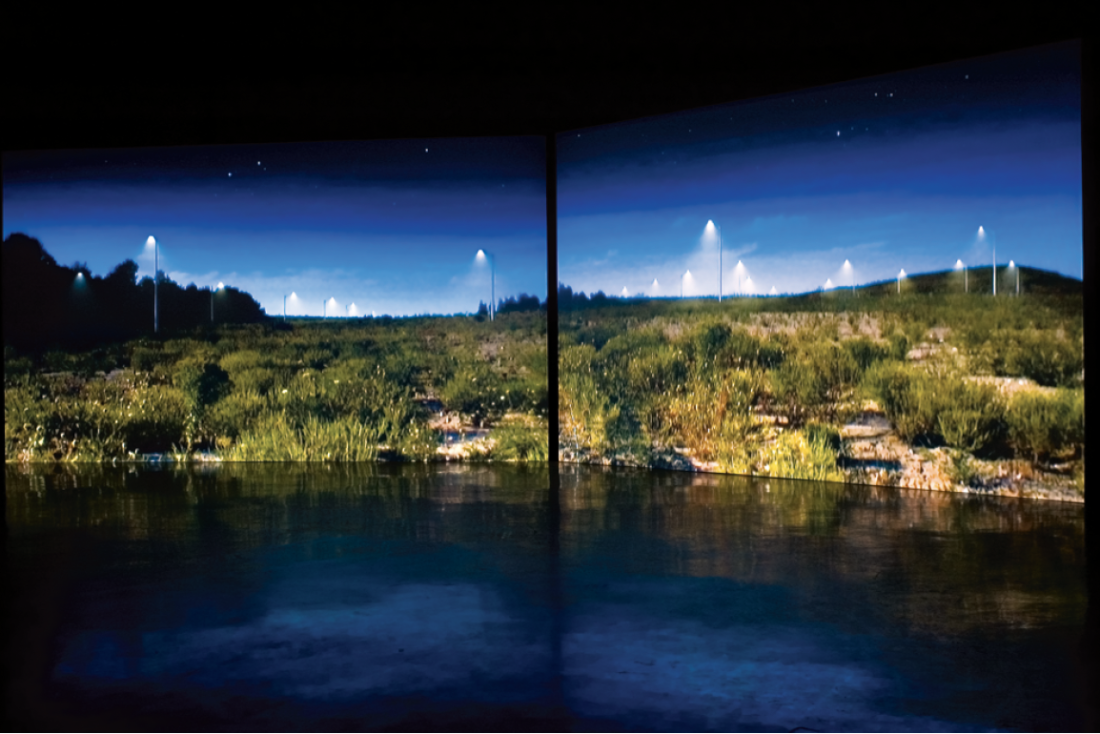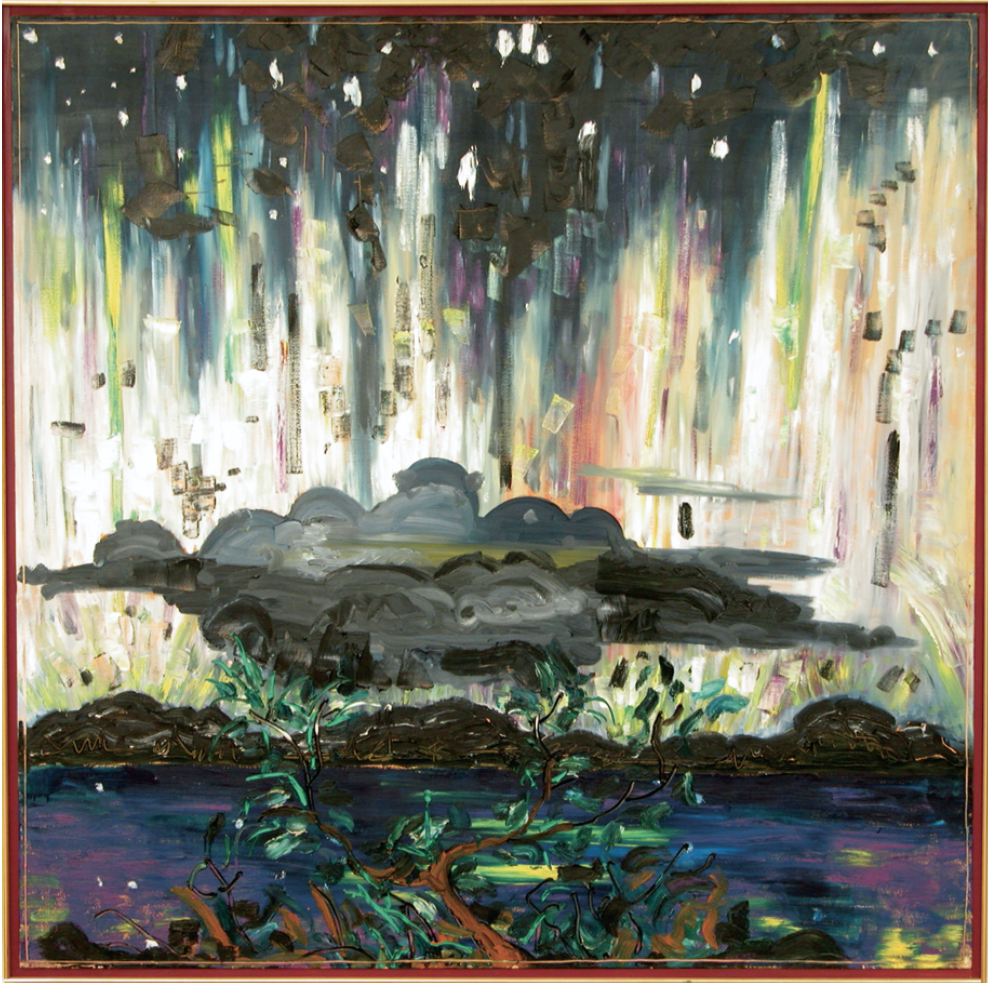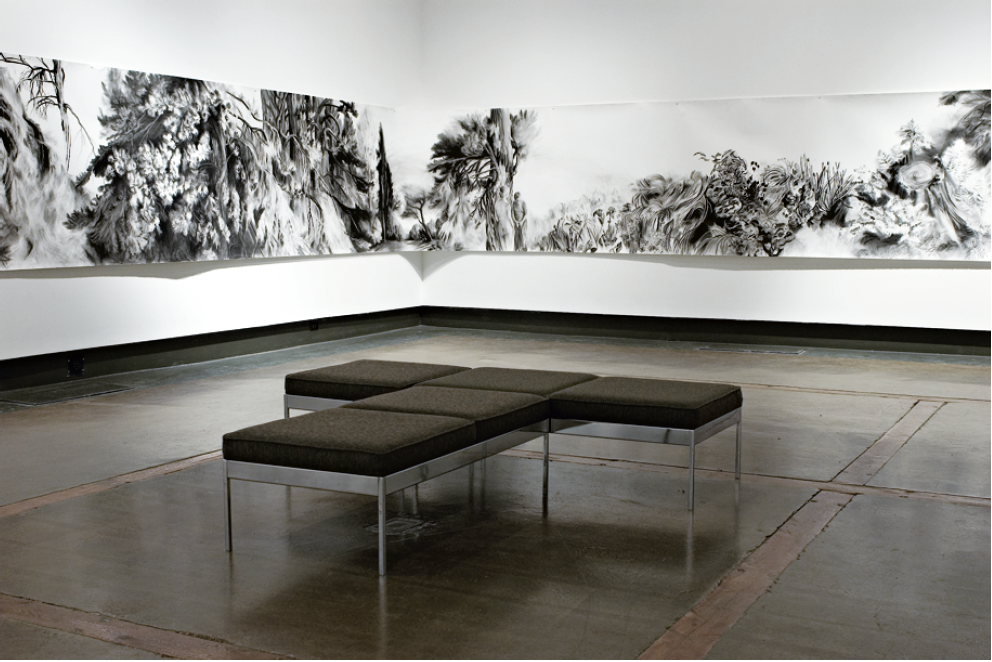Landscape x 4: Geoffrey James, Alex Cameron, Jennifer Stead, Kelly Richardson
Urbanization brings out a nostalgia for pastoral and wild landscapes; with 80% of Canadians now living in urban centres, the continuing popularity of landscape art in mainstream culture is not surprising. Contemporary artists, however, have had a difficult time with the cliché-ridden genre. Generally, they shy away from the beauty of the natural landscape, mesmerized as they are by the turmoil of the city and its bordering wastelands, and the infinite territories of technology. “The hardest thing to do is photograph beautiful things,” photographer Geoffrey James remarked in an interview with Border Crossings (issue no. 81, 2002).
The Kitchener-Waterloo Art Gallery (KW/AG) has, in several exhibitions in recent years, investigated contemporary landscape art as it relates to its history in painting, when beauty, the picturesque and the sublime were still the stuff of landscape. This winter, four concurrent exhibitions were shown that appear to revalidate the landscape genre for the present, catching, just in time, the disappearing beauty of the land. In the process, and perhaps unintended, not only the genre of landscape, but also its equally antiquated media of painting (Alex Cameron), drawing (Jennifer Stead) and analogue photography (Geoffrey James) are revalidated through the sheer joy and craftsmanship the artists convey. Using new media, Kelly Richardson overlays the traditional landscape with signs of an electronic age, but even these landscapes are rendered wondrous and beautiful.

Kelly Richardson, Forest Park, 2007, two-channel widescreen video projection. Photo: Katrina Jennifer Bedford, KW/AG.
Of the four artists, only James stayed within the area. The ordinary farmers’ fields along the Conestogo River, close to Waterloo, were a fitting subject for this artist, who has become well known for photographing changes in the life of specific regions or cities. “I am interested when things remain that by rights shouldn’t,” he has said, and the Mennonite farming country on the very edge of the expanding modern city is just such a thing. In Field Notes, we see peaceful, pastoral scenes of rolling fields with grazing cattle, void of human beings. Gnarled trees, some surrounded by broken branches, have witnessed a passing of time that seems marked only by the changing seasons. A tilled field stretches to an endless horizon; a low point of view provides a rich detail of vegetation in the foreground. James’s use of black and white photography accentuates a sense of tradition by providing a continuum, stretching forward from photography’s original purpose of documenting “reality.” But this focus on history also serves to throw the few visible signs of change in sharp relief. How dare that monster house spoil the horizon of this idyllic scene?

Geoffrey James, From the Series “Field Notes”, 2007. Image courtesy the artist and KW/AG.
Where James shows a love of agrarian landscape and photography, Alex Cameron shows his love of the Canadian wilderness and painting in the exhibition “Changing Weather.” Cameron’s vibrant colours and mercurial dashes and lines demonstrate that painting and wild nature—as in the Group of Seven—still make a good match. The selection from KW/AG’s permanent collection consists of earlier landscapes, some of which could be read as an homage to the iconic Seven. Like them, Cameron seeks the solitude of the wild, and brings back his paintings from wild places such as the Rocky Mountains and Georgian Bay. Well aware of the threatened state of nature, he speaks about wanting to paint “the essence of our land before its final disappearance.” Cameron, who paints abstract works based on landscape, as well as representational landscapes, may not succeed in capturing the land’s “essence” any more than the Group of Seven did. What he does show, however, is that a strong sense of connectivity to nature can still be expressed in paint. There is a sense of free play, of wildness, in Cameron’s exuberant brush strokes that remind me of a quote by Thoreau: “It is in vain to dream of a wildness distant from ourselves.” If, as Thoreau also said, “In wildness lies the preservation of the world,” Cameron’s works show that painting, as much as the wildness of nature, is worth preserving.

Alex Cameron, The Big Night of Lights at True North Lake, 1987, oil on canvas, 187 x 182 cm. Collection of the Kitchener-Waterloo Art Gallery, gift of Mr. Irving Zucker, 1993. Image courtesy the artist and KW/AG.
Jennifer Stead’s Meander 100’, a drawing on a paper scroll that unfurls to 100 feet, speaks of a different kind of connectivity to the landscape, of an ongoing process of finding one’s self reflected in the natural environment. Stead, who lives in Banff, created her imaginary nature scenes through a process of sifting through memories and musings, retained from daily walks in the area. Each day she rolled up the work of the previous day, then unrolled a few more feet of paper to continue the drawing. Instead of “taking a line for a walk,” as Paul Klee would have his students do, Stead takes a walk for a line, rendering and transforming her experiences of nature, and thereby folding a sense of wonder into her own life. Meander 100’ is a work of beauty and dazzling draughtsmanship, yet the simplicity of the process of drawing with charcoal on paper collapses all barriers between artist and viewer. The work’s lateral extension accentuates the viewer’s sense of intimate involvement. The scroll is an invitation to walk alongside the artist and ponder some of the means to create meaning in our lives that we, as techno-urbanites, are losing: not just our connection to nature, but drawing as a basic mode of self-understanding.

Jennifer Stead, Meander 100’, 2007, detail, charcoal on Stonehenge paper, 52” x 100’. Photo: Katrina Jennifer Bedford, KW/AG.
As transparent and direct as the process of drawing is, Kelly Richardson’s digital means, instead, are opaque and mediated. Yet these digitally manipulated video projections are crucial participants in the discussion on landscape in which the exhibitions at the KW/AG are engaged. Exiles of the Shattered Star shows a still of a nondescript landscape—lake, hills and sky—in which slowly, silently, relentlessly, fireballs fall from the sky and disappear into the earth and water. A bucolic soundtrack of twittering birds accompanies the video. Her second work, Forest Park, is a two-channel video projection. It shows a vacant field, above which—in advance of new housing development— a flock of streetlights hover, flickering to the rhythm of chirping crickets. Richardson’s use of new media draws her phantasmagoric landscapes into a current, everyday reality, more so than the works of the other artists. By digitally disintegrating the unity of her landscape images, she appears to identify new technology as a threat to tradition and nature. Still, she uses these very same means to evoke a new, wondrous sense of beauty that has traditionally been associated with landscape representation.
Richardson, then, is not an anomaly in this quartet of landscape exhibitions. A non-ironic, pro-art sensibility comes through, even in her use of new media. All four artists show what is worth holding on to in changing times: a passionate connection to the natural landscape, preserved through art. ■
“Geoffrey James: Field Notes,” “Kelly Richardson: Forest Park,” “Jennifer Stead: Meander 100’” and “Alex Cameron: Changing Weather” were exhibited at the Kitchener-Waterloo Art Gallery from January 11 to March 23, 2008.
Petra Halkes is a painter and critic living in Ottawa. She is the author of Aspiring to the Landscape, On Painting and the Subject of Nature (University of Toronto Press, 2006).

